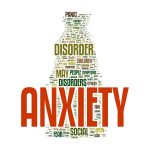Most people experience feelings of anxiety before an important event such as a big exam, business presentation or first date. Anxiety disorders, however, are illnesses that cause people to feel frightened, distressed and uneasy for no apparent reason. Left untreated, these disorders can dramatically reduce productivity and significantly diminish an individual's quality of life.Fortunately, through research conducted by the National Institute of Mental Health (NIMH), there are effective treatments that can help. NIMH is conducting a national education campaign to increase awareness of these disorders and their treatments.
How Common Are Anxiety Disorders?
Anxiety disorders are the most common mental illnesses in America: more than 19 million are affected by these debilitating illnesses each year. Anxiety disorders cost the U.S. $46.6 billion in 1990 in direct and indirect costs, nearly one-third of the nation's total mental health bill of $148 billion.
What Are the Different Kinds of Anxiety Disorders?
Panic Disorder—Repeated episodes of intense fear that strike often and without warning. Physical symptoms include chest pain, heart palpitations, shortness of breath, dizziness, abdominal distress, feelings of unreality, and fear of dying.
Obsessive-Compulsive Disorder—Repeated, unwanted thoughts or compulsive behaviors that seem impossible to stop or control.
Post-Traumatic Stress Disorder—Persistent symptoms that occur after experiencing a traumatic event such as rape or other criminal assault, war, child abuse, natural disasters or crashes. Nightmares, flashbacks, numbing of emotions, depression and feeling angry, irritable, distracted and being easily startled are common.
Phobias—Two major types of phobias are specific phobia and social phobia.
- People with specific phobia experience extreme, disabling, and irrational fear of something that poses little or no actual danger; the fear leads to avoidance of objects or situations and can cause people to limit their lives unnecessarily.
- People with social phobia have an overwhelming and disabling fear of scrutiny, embarrassment, or humiliation in social situations, which leads to avoidance of many potentially pleasurable and meaningful activities.
Generalized Anxiety Disorder—Constant, exaggerated worrisome thoughts and tension about everyday routine life events and activities, lasting at least six months. Almost always anticipating the worst even though there is little reason to expect it; accompanied by physical symptoms, such as fatigue, trembling, muscle tension, headache, or nausea.
What Are the Treatments for Anxiety Disorders?
Medications:
Although they are not cures, medications can be very effective at relieving anxiety symptoms. These include antidepressants or benzodiazepines. Today's treatments are extremely effective and often involve the combination of medication with specific types of psychotherapy. There are more medications available than ever before to treat anxiety disorders, so if one drug is not successful, there are usually others to try. In addition, new medications to treat anxiety symptoms are under development. For most of the medications that are prescribed to treat anxiety disorders, the doctor usually starts the patient on a low dose and gradually increases it to the full dose.
Every medication has side effects, but they usually become tolerated or diminish with time. If side effects become a problem, the doctor may advise the patient to stop taking the medication and to wait a week—or longer for certain drugs—before trying another one.
When treatment is near an end, the doctor will taper the dosage gradually.
Psychotherapy:
Research has also shown that behavioral therapy and cognitive-behavioral therapy can be effective for treating several of the anxiety disorders.
Behavioral therapy:
This type of therapy focuses on changing specific actions and uses several techniques to decreases or stop unwanted behavior. For example, one technique trains patients in diaphragmatic breathing, a special breathing exercise involving slow, deep breaths to reduce anxiety. This is necessary because people who are anxious often hyperventilate, taking rapid shallow breaths that can trigger rapid heartbeat, lightheadedness, and other symptoms. Another technique—exposure therapy—gradually exposes patients to what frightens them and helps them cope with their fears.
Cognitive-behavioral therapy:
Like behavioral therapy, cognitive-behavioral therapy teaches patients to react differently to the situations and bodily sensations that trigger panic attacks and other anxiety symptoms. However, patients also learn to understand how their thinking patterns contribute to their symptoms and how to change their thoughts so that symptoms are less likely to occur. This awareness of thinking patterns is combined with exposure and other behavioral techniques to help people confront their feared situations.
For example, someone who becomes lightheaded during a panic attack and fears he is going to die can be helped with the following approach used in cognitive-behavioral therapy. The therapist asks him to spin in a circle until he becomes dizzy. When he becomes alarmed and starts thinking, “I'm going to die,” he learns to replace that thought with a more appropriate one, such as “It's just a little dizziness—I can handle it.”
Is it Possible for Anxiety Disorders to Coexist with Other Physical or Mental Disorders?
It is common for an anxiety disorder to accompany another anxiety disorder, or in some cases depression, eating disorders or substance abuse.
Anxiety disorders can also coexist with physical disorders. In such instances, these disorders will also need to be treated. Before undergoing any treatment, it is important to have a thorough medical exam to rule out other possible causes.
Many people with anxiety disorders can be helped with the type of treatments mentioned here. The best therapy is that which has been developed together with your personal physician and tailored to your specific needs, goals, and objectives.
Modified from information provided by the National Institute of Mental Health









